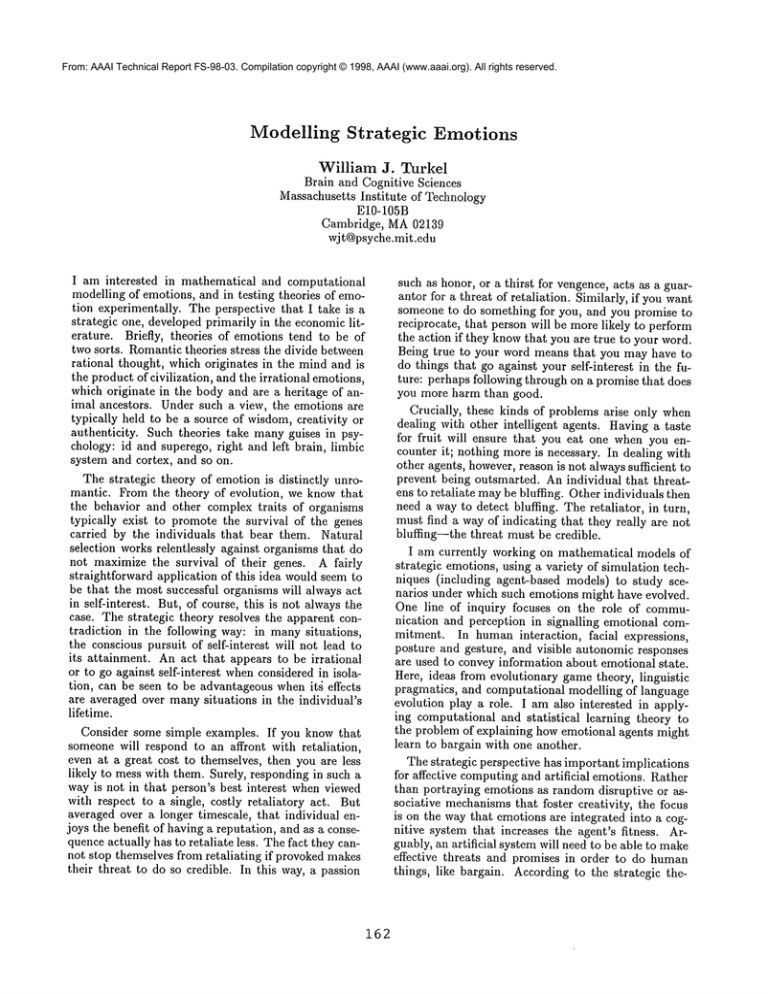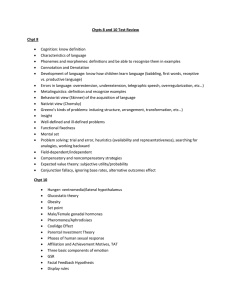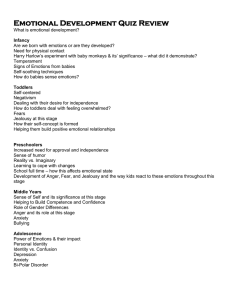
From: AAAI Technical Report FS-98-03. Compilation copyright © 1998, AAAI (www.aaai.org). All rights reserved.
Modelling
Strategic
Emotions
William
J. Turkel
Brain and Cognitive Sciences
Massachusetts Institute of Technology
E10-105B
Cambridge, MA02139
wjt@psyche.mit.edu
I am interested in mathematical and computational
modelling of emotions, and in testing theories of emotion experimentally. The perspective that I take is a
strategic one, developed primarily in the economicliterature. Briefly, theories of emotions tend to be of
two sorts. Romantictheories stress the divide between
rational thought, which originates in the mind and is
the product of civilization, and the irrational emotions,
which originate in the body and are a heritage of animal ancestors. Under such a view, the emotions are
typically held to be a source of wisdom,creativity or
authenticity. Such theories take many guises in psychology: id and superego, right and left brain, limbic
system and cortex, and so on.
The strategic theory of emotion is distinctly unromantic. From the theory of evolution, we know that
the behavior and other complex traits of organisms
typically exist to promote the survival of the genes
carried by the individuals that bear them. Natural
selection works relentlessly against organisms that do
not maximize the survival of their genes. A fairly
straightforward application of this idea would seem to
be that the most successful organisms will always act
in self-interest. But, of course, this is not always the
case. The strategic theory resolves the apparent contradiction in the following way: in manysituations,
the conscious pursuit of self-interest will not lead to
its attainment. An act that appears to be irrational
or to go against self-interest whenconsidered in isolation, can be seen to be advantageous when it~ effects
are averaged over manysituations in the individual’s
lifetime.
Consider some simple examples. If you know that
someone will respond to an affront with retaliation,
even at a great cost to themselves, then you are less
likely to mess with them. Surely, responding in such a
way is not in that person’s best interest when viewed
with respect to a single, costly retaliatory act. But
averaged over a longer timescale, that individual enjoys the benefit of having a reputation, and as a consequence actually has to retaliate less. The fact they cannot stop themselves from retaliating if provoked makes
their threat to do so credible. In this way, a passion
162
such as honor, or a thirst for vengence, acts as a guarantor for a threat of retaliation. Similarly, if you want
someone to do something for you, and you promise to
reciprocate, that person will be more likely to perform
the action if they knowthat you are true to your word.
Being true to your word means that you may have to
do things that go against your self-interest in the future: perhaps following through on a promise that does
you more harm than good.
Crucially, these kinds of problems arise only when
dealing with other intelligent agents. Having a taste
for fruit will ensure that you eat one when you encounter it; nothing more is necessary. In dealing with
other agents, however,reason is not always sufficient to
prevent being outsmarted. An individual that threatens to retaliate maybe bluffing. Other individuals then
need a way to detect bluffing. The retaliator, in turn,
must find a way of indicating that they really are not
bluffing--the threat must be credible.
I am currently working on mathematical models of
strategic emotions, using a variety of simulation techniques (including agent-based models) to study scenarios under which such emotions might have evolved.
One line of inquiry focuses on the role of communication and perception in signalling emotional commitment. In human interaction,
facial expressions,
posture and gesture, and visible autonomic responses
are used to convey information about emotional state.
Here, ideas from evolutionary game theory, linguistic
pragmatics, and computational modelling of language
evolution play a role. I am also interested in applying computational and statistical
learning theory to
the problem of explaining how emotional agents might
learn to bargain with one another.
The strategic perspective has important implications
for affective computingand artificial emotions. Rather
than portraying emotions as random disruptive or associative mechanismsthat foster creativity, the focus
is on the way that emotions are integrated into a cognitive system that increases the agent’s fitness. Arguably, an artificial system will need to be able to make
effective threats and promises in order to do human
things, like bargain. According to the strategic the-
ory, such threats must be credible. In humanbeings,
emotions such as fear, anger and honor underwrite the
credibility. But if a user has no reason to fear the
computer, then its threats are empty. Likewise, if the
computer has no powerto fulfill promises, then it cannot make them. And a computer that cannot be angry
with you cannot really like you either.
163









